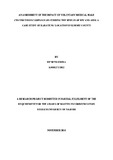| dc.description.abstract | This study assessed the impact of voluntary medical male circumcision on curbing the spread
of HIV and AIDS. The study had five objectives. It used descriptive research design and
purposive sampling, where participants, opinion leaders and health workers were targeted for
data collection. It used qualitative data collection technique, where interview guides and
schedules were applied to collect data from Focus Group Discussions and key informants.
Thematic data analysis was used and presentation done using narrative approach. The
findings indicate that despite people, especially the young, embracing circumcision, the
practice has not changed behaviour patterns, as people continue to engage in risky sexual
encounters that expose them to HIV. The study also found out that most people who
underwent the cut were influenced by peers and opinion leaders, with majority saying
careless sexual behaviours among the circumcised had increased. It also established that
communication on reasons for circumcision was not well stipulated; a shortfall that has kept
away the older population, as the already circumcised believe transmission was due to the
foreskin, hence removal thereby meant lowering risk. The study recommends enhancing
communication campaigns to reach the public and to clarify what in can achieve and what
cannot be guaranteed. The study also recommends the 60 percent prevention success be
accompanied by a rider message that if circumcised population adheres to other interventions
such as condom use, being faithful and testing. It also recommends the health sector injects
more resources that will enhance the campaign, while circumcising more young male
population, who will then cascade benefits to older population. This way, all males who go
for circumcision will be informed on its benefits. | en_US |

